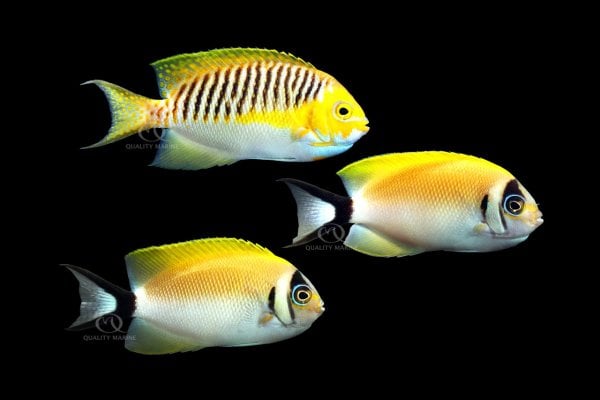Everyone wants an Angel. This is all well and good for those of us who aren't interested in keeping corals or other sessile (stuck in one place) invertebrates. Where this gets complicated is for the aquarists among us who desire to have both an Angel, AND corals. It's kind of an unwritten guideline in reef keeping that there aren't many iron-clad rules, so we don't like to say “that's not possible” or “that'll never work” very often. With this in mind, we'd like to strongly caution you against housing the vast majority of Angelfish in tanks that have corals or sponges that you would like to keep. Fish from the Genus Pomacanthus, Holacanthus, Chaetodontoplus, Apolemichthys will (sooner than later) try to eat your corals. Even Centropyge (and Paracentropyge) which we've seen in countless reef tanks will generally, sooner or later, succumb to the call of the coral polyp cafe.
There is however, one genus of Angelfish that is extraordinarily unlikely to munch your corals and to this end, we give you Genicanthus, a group better known as Swallowtail Angels. They get this name from their crescent shaped tails which they share with the small fighter jet birds called swallows. (This tail shape is also called lunate for its resemblance to a crescent moon.) There are lots of choices available in regard to Swallowtail Angels for your reef aquarium these days, but perhaps the coolest of them all is the Japanese Swallowtail Angel. They are also frequently called Masked Swallowtail Angel; in Japan they go by the name Tosayakko. The scientific name for them is Genicanthus semifasciatus.
These fish are planktivores in the wild, and very used to eating suspended foods. This not only makes them easy to feed, as they will sample just about anything floating past that will fit into their small mouths. Here they get a mix of Frozen (thawed obviously) foods from Gamma like Mysis, Copepods, all their fortified Brine, and chopped prawn. Most specimens will quickly accept Nutramar Complete Pellets if introduced at the same time as the meatier foods. We recommend making at least 2 feedings a day, and a portion of this should the Nutramar Pellets as they offer unrivaled nutrition and protein density. Click here to read more

There is however, one genus of Angelfish that is extraordinarily unlikely to munch your corals and to this end, we give you Genicanthus, a group better known as Swallowtail Angels. They get this name from their crescent shaped tails which they share with the small fighter jet birds called swallows. (This tail shape is also called lunate for its resemblance to a crescent moon.) There are lots of choices available in regard to Swallowtail Angels for your reef aquarium these days, but perhaps the coolest of them all is the Japanese Swallowtail Angel. They are also frequently called Masked Swallowtail Angel; in Japan they go by the name Tosayakko. The scientific name for them is Genicanthus semifasciatus.
These fish are planktivores in the wild, and very used to eating suspended foods. This not only makes them easy to feed, as they will sample just about anything floating past that will fit into their small mouths. Here they get a mix of Frozen (thawed obviously) foods from Gamma like Mysis, Copepods, all their fortified Brine, and chopped prawn. Most specimens will quickly accept Nutramar Complete Pellets if introduced at the same time as the meatier foods. We recommend making at least 2 feedings a day, and a portion of this should the Nutramar Pellets as they offer unrivaled nutrition and protein density. Click here to read more












